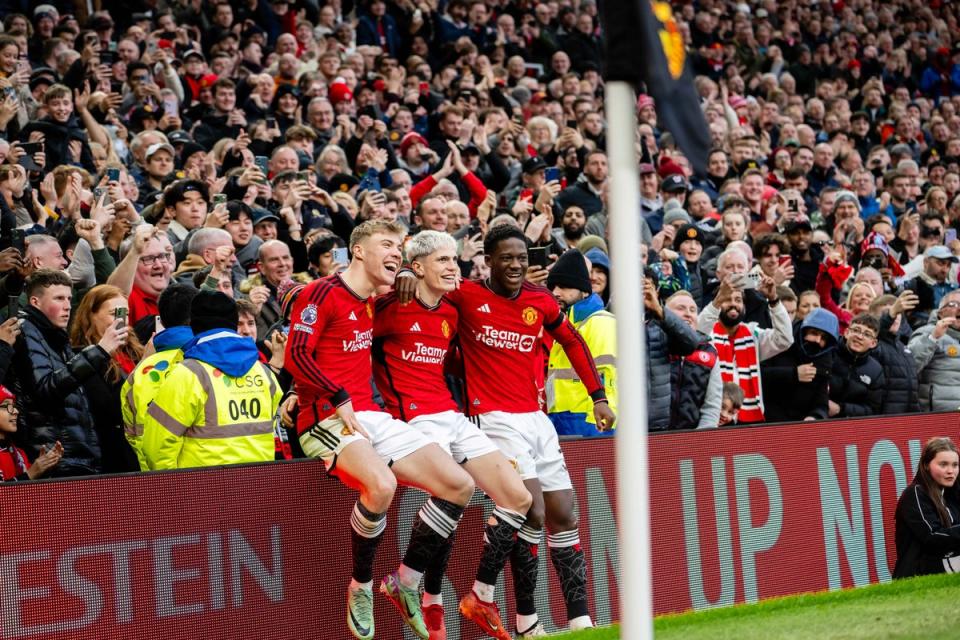Rasmus Hojlund is finally showing why he will be Manchester United’s next great Dane
Rasmus Hojlund talked about the present on a day that offered a vision of Manchester United’s future. The gift was because he turned 21. Arguably, though, he came of age on Boxing Day, the evening he capped a comeback against Aston Villa, the night his own drought turned into a flood.
Most of the definitive United forwards have made an auspicious start, scoring early. Not Hojlund: not in the Premier League, anyway. His first 14 outings yielded no goals and, for good measure, no assists. Since then he has scored four and made two in four matches: a gliding, thumping opener against West Ham may have been the pick of the bunch. “I got my present in the morning and now I got an even bigger one so I am happy,” he said, but this was earned, not wrapped. It made for a fine birthday for a rough diamond. United invested a lot of hope and money in Hojlund when he was 20. For much of his debut campaign at Old Trafford, he has been outscored by Scott McTominay. For three months, he trailed behind Hannibal Mejbri for league goals.

Since Christmas, however, only two players have scored more often in the Premier League; only Wolves’ Matheus Cunha has been directly involved in more goals. There were always encouraging signs in autumn, and not merely in the five Champions League goals that render him the competition’s joint top scorer. Now there is added evidence Hojlund has the ingredients to become a high-class forward, United’s next great Dane.
“I have always believed in myself, it has just been about getting the rhythm going,” he said. Confidence, too, and the way he skipped past Nayef Aguerd before scoring spoke to his belief. “You get one goal, then two and get a bit of momentum and start linking up with the players.” Two burgeoning alliances offer particular hope. Ten Hag has talked about the connection between Hojlund and Rashford. The win against West Ham was based on another double act: the Dane and Alejandro Garnacho, who was electric.
“About a month ago, Garna and I did an interview on the pitch and he said there was a lot of talk about us not scoring enough goals but we’re still young,” Hojlund said. The Argentinian registered a second brace in three home matches. Like Hojlund, he allies the ability with the character to play for United.
That has formed part of the reason why it has always felt Hojlund would come good. His has had to be a huge burden but he has not shrunk from it. As he has admitted, the Premier League is faster than Serie A and it took time to adjust. But United’s plight meant he could not be eased into action. He was instead plunged into it: by a lack of alternatives, by the fact every game felt must-win, by the lack of goals from Antony and Rashford. Now, with Anthony Martial out until April, with Ten Hag frustrated in his hopes to sign a striker in January, United’s slight chances of Champions League football rest to a large degree on Hojlund.

Perhaps Ten Hag’s future, too: while Ineos conduct their audit, a failure to qualify for the premier European competition has tended to be fatal for United managers under their co-owners, the Glazers. If Ten Hag goes, the best part of his legacy may lie in the forward line: in Hojlund, Garnacho and last season’s rejuvenation of Rashford, albeit tarnished by this season’s troubles.
And if Ten Hag’s case to carry on is weakened by his record in the transfer market, Hojlund at least offers some return from last summer’s recruitment drive. Only Jonny Evans of the other six additions then can be called a success, and that is in the context of a 35-year-old on a free transfer, an afterthought with no longevity.
Thus far, Andre Onana, Mason Mount and Sofyan Amrabat have all failed, even if the Englishman can plead injuries in mitigation. Hojlund represented a case of forward planning, in more ways than one. In a sense, he was the anti-Harry Kane: lacking the guarantee, lacking the immediate impact, but an investment in the late 2020s and early 2030s. Ten Hag is not in charge of negotiating but United paid over the odds for Hojlund: £64m rising to £72m. Overpaying for the wrong player is double damning, as Antony proves; for the right one, however, it at least has a certain logic.
As Lisandro Martinez went off with an injury that Ten Hag described as a potential “disaster”, the Dutchman lost his best signing; given his combination of combativity at the back and passing to launch attacks, his best formula. But at least in Hojlund, United have a fit, scoring, specialist striker for the first time in Ten Hag’s reign. But not, in all probability, the last time in Hojlund’s time at Old Trafford.

 Yahoo Sport
Yahoo Sport 



































































